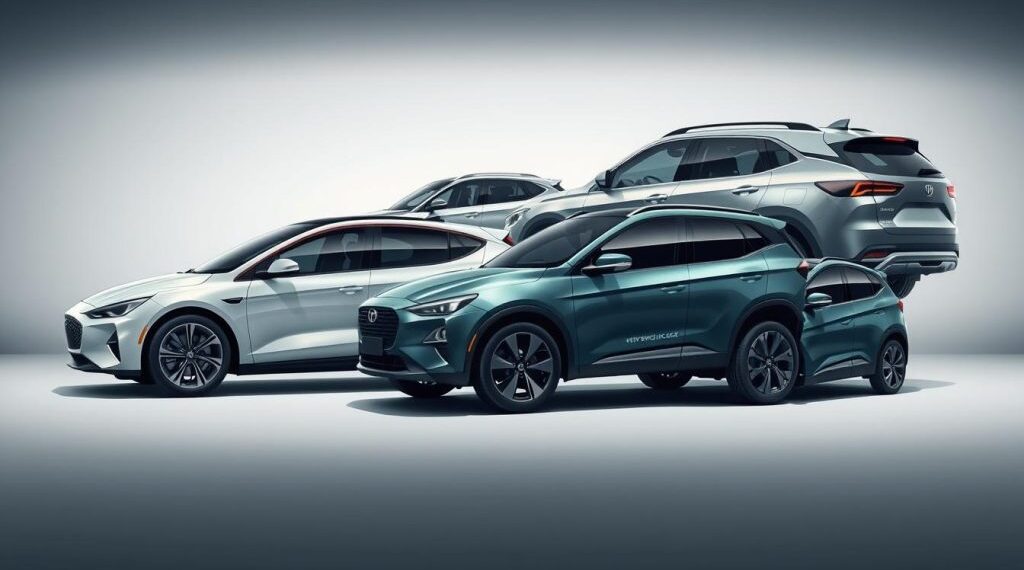Understanding the Core Characteristics of Sedans: Design, Functionality, and Market Trends
Sedans, a mainstay in the automotive world, are characterized by their three-box configuration and enclosed passenger compartment. This design offers a balance of practicality and comfort, making them a popular choice for a wide range of drivers.
1. Defining the Sedan Design
The classic sedan design features three distinct sections: the engine compartment, the passenger area, and the cargo trunk. This “three-box” design separates the passenger space from the engine noise and provides a dedicated storage area. Sedans typically have four doors and a traditional roofline, although variations like fastback sedans are also available. The emphasis is often on providing a comfortable and refined driving experience.
2. Functionality and Practicality
Sedans are known for their practicality and versatility. They offer ample seating for passengers and a separate trunk for luggage or groceries. Their relatively compact size makes them easier to maneuver and park in urban environments compared to larger vehicles like SUVs. Sedans are also often more fuel-efficient than larger vehicles, making them a cost-effective choice for daily commuting and long road trips.
3. Market Trends and Popularity
While SUVs and crossovers have gained significant market share, sedans remain a relevant segment. Automakers continue to innovate with new technologies and designs to attract buyers. Hybrid and electric sedans are becoming increasingly popular, reflecting a growing demand for fuel-efficient and environmentally friendly vehicles. The market is also seeing a trend towards more luxurious and feature-rich sedans, catering to drivers seeking a premium driving experience.
Exploring the Versatility of SUVs: From Off-Road Adventures to Urban Utility
SUVs, or Sport Utility Vehicles, have become increasingly popular due to their adaptability, catering to both adventurous off-road experiences and practical urban commuting needs. Their blend of space, power, and features makes them a compelling choice for many drivers.
1. Defining the SUV Category
SUVs are characterized by their truck-based platforms, offering higher ground clearance and a more commanding driving position. This design often translates to enhanced capabilities in various terrains and weather conditions, setting them apart from traditional sedans or hatchbacks. The term “SUV” encompasses a wide range of sizes and functionalities, from compact SUVs designed for city living to full-size models built for towing and hauling.
2. Off-Road Capabilities and Features
Many SUVs are equipped with features that enhance their off-road performance. These can include four-wheel-drive systems, specialized traction control, and robust suspension systems. These features allow SUVs to navigate challenging terrains such as dirt roads, rocky trails, and snowy conditions, making them ideal for outdoor enthusiasts and those living in areas with unpredictable weather.
3. Urban Utility and Practicality
Beyond their off-road prowess, SUVs also excel in urban environments due to their practicality and versatility. Their spacious interiors offer ample room for passengers and cargo, making them suitable for families and individuals with active lifestyles. Features like rear parking sensors, blind-spot monitoring, and advanced driver-assistance systems (ADAS) enhance safety and convenience in congested city streets.
The Evolution of Pickup Trucks: Balancing Power, Utility, and Modern Innovations
Pickup trucks have transformed from basic work vehicles to versatile machines, blending robust capabilities with modern comfort and technology. Their evolution reflects changing consumer needs and technological advancements in the automotive industry.
1. The Rise of the Modern Pickup
Modern pickup trucks are a far cry from their utilitarian ancestors. Once solely designed for hauling and towing, they now feature luxurious interiors, advanced safety features, and cutting-edge infotainment systems. This shift caters to a broader audience seeking both practicality and comfort in a single vehicle. The integration of technology like adaptive cruise control and lane-keeping assist has further enhanced the driving experience, making pickup trucks more appealing for daily commuting and family trips.
2. Powertrain Innovations and Efficiency
The evolution of powertrains has significantly impacted the performance and efficiency of pickup trucks. Modern engines, including turbocharged options and hybrid systems, deliver impressive power while minimizing fuel consumption. Electric pickup trucks are also emerging, promising zero-emission operation and instant torque. These innovations reflect a growing emphasis on sustainability and reduced environmental impact in the automotive industry.
3. Design and Customization Trends
Pickup truck design has become increasingly sophisticated, with manufacturers offering a wide range of trims, colors, and customization options. From rugged off-road packages to sleek, urban-oriented styles, there’s a pickup truck to suit every taste and lifestyle. The availability of aftermarket accessories further allows owners to personalize their vehicles, reflecting individual preferences and needs. This focus on design and customization has contributed to the growing popularity of pickup trucks as lifestyle vehicles.
Decoding Sports Cars: Performance, Design, and Technological Advancements
Sports cars represent the pinnacle of automotive engineering, blending high performance with striking aesthetics and cutting-edge technology to deliver an exhilarating driving experience.
1. Performance Metrics
Sports cars are engineered for superior performance, typically characterized by powerful engines, responsive handling, and rapid acceleration. Key performance indicators include 0-60 mph acceleration times, top speed, and horsepower. For example, the 2024 Porsche 911 Turbo S boasts a 0-60 mph time of around 2.6 seconds, showcasing the extreme capabilities achievable through advanced engine technology and aerodynamic design. These cars often feature specialized suspension systems and high-performance tires to maximize grip and control on the road or track.
2. Design and Aerodynamics
The design of a sports car is crucial for both aesthetics and performance. Sleek lines, low profiles, and aerodynamic enhancements such as spoilers and diffusers are common features. These elements not only contribute to the car’s visual appeal but also improve its stability and handling at high speeds by reducing drag and increasing downforce. The exterior design often reflects the car’s performance-oriented nature, with aggressive styling cues and distinctive features that set it apart from other vehicle types.
3. Technological Innovations
Modern sports cars incorporate a range of technological advancements to enhance performance and driver experience. These include advanced driver-assistance systems (ADAS), such as electronic stability control and traction control, which help to maintain control in challenging driving conditions. Furthermore, many sports cars feature advanced infotainment systems, digital dashboards, and connected car technologies. The integration of these technologies provides drivers with real-time performance data, navigation assistance, and access to various entertainment options.
Electric Vehicles Unveiled: Technology, Environmental Impact, and Future Prospects
Electric vehicles (EVs) are gaining prominence as a sustainable alternative to traditional gasoline-powered cars. They represent a significant shift in automotive technology, driven by environmental concerns and advancements in battery technology.
| Feature | Electric Vehicles (EVs) | Internal Combustion Engine Vehicles (ICEVs) |
|---|---|---|
| Fuel Source | Electricity | Gasoline/Diesel |
| Emissions | Zero tailpipe emissions | Significant emissions |
| Running Cost | Lower | Higher |
| Maintenance | Lower | Higher |
| Purchase Price | Higher initially | Lower initially |
| Refueling/Recharge | Charging | Fueling |
Data source: International Energy Agency (IEA), 2024.
1. Core Technology
Electric vehicles primarily rely on battery electric technology. A large battery pack powers one or more electric motors. These motors convert electrical energy into mechanical energy, propelling the vehicle forward. Regenerative braking, which captures energy during deceleration and feeds it back into the battery, further enhances efficiency. Advancements in battery technology, such as lithium-ion and solid-state batteries, are continuously improving EV range, charging times, and overall performance. The integration of sophisticated power electronics and control systems ensures smooth and efficient operation.
2. Environmental Benefits
EVs offer substantial environmental advantages compared to conventional vehicles. They produce zero tailpipe emissions, reducing air pollution in urban areas. While electricity generation can still contribute to emissions, the overall carbon footprint of EVs is generally lower, especially when powered by renewable energy sources like solar and wind. The lifecycle environmental impact of EVs, including manufacturing and battery disposal, is a subject of ongoing research and improvement. The shift to EVs plays a crucial role in mitigating climate change and promoting cleaner transportation.
3. Market Trends and Future Growth
The electric vehicle market is experiencing rapid growth worldwide. Government incentives, increasing consumer awareness, and expanding charging infrastructure are driving adoption. Automakers are investing heavily in EV development, introducing a wider range of models to cater to different market segments. BloombergNEF projects that electric vehicles could account for 73% of new car sales globally by 2040. The future of transportation is undoubtedly electric, with continuous innovation and decreasing costs making EVs increasingly accessible and appealing to consumers.
Q&A
Question 1: What are the defining characteristics of a sedan, and what makes it a popular choice for many drivers?
Answer: Sedans are characterized by their three-box design (engine compartment, passenger area, and trunk), four doors, and a traditional roofline. This design provides a balance of practicality (ample passenger space and dedicated storage) and comfort, making them appealing to a wide range of drivers. Their relatively compact size also contributes to their maneuverability and ease of parking.
Question 2: How do SUVs differ from sedans in terms of design, functionality, and target market?
Answer: SUVs, or Sport Utility Vehicles, are built on truck-based platforms, providing higher ground clearance and a more commanding driving position than sedans. This translates to better off-road capabilities and enhanced versatility. While sedans prioritize comfort and fuel efficiency, SUVs emphasize space, power, and adaptability for both urban and off-road use, appealing to families and outdoor enthusiasts.
Question 3: What are some key technological advancements and design trends observed in modern pickup trucks?
Answer: Modern pickup trucks have evolved significantly from their utilitarian predecessors. They now boast substantially increased horsepower, greater payload capacity, and improved fuel efficiency thanks to technological advancements in engine design. Furthermore, they incorporate advanced infotainment systems, driver-assistance features, and a wider range of customization options, appealing to a broader consumer base beyond purely work-related use.
Question 4: What are the key performance metrics and technological features that define a modern sports car?
Answer: Sports cars are defined by their high performance, typically characterized by powerful engines resulting in rapid acceleration (low 0-60 mph times), high top speeds, and impressive horsepower. Beyond performance, technological advancements such as advanced driver-assistance systems (ADAS), sophisticated infotainment systems, and aerodynamic design elements contribute to both the driving experience and the car’s overall appeal.
References:
- https://www.edmunds.com/car-reviews/popular-car-comparisons.html
- https://www.caranddriver.com/news/g64457986/bestselling-cars-2025/
- https://afdc.energy.gov/vehicles/search/download.pdf
- https://www.kbb.com/cars/best-mid-size-cars/2025/
- https://www.youtube.com/watch?v=KS3UQ9QSoGM






